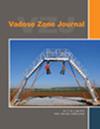Same soil, different climate: Crop model intercomparison on translocated lysimeters
IF 2.5
3区 地球科学
Q3 ENVIRONMENTAL SCIENCES
引用次数: 3
Abstract
Crop model intercomparison studies have mostly focused on the assessment of predictive capabilities for crop development using weather and basic soil data from the same location. Still challenging is the model performance when considering complex interrelations between soil and crop dynamics under a changing climate. The objective of this study was to test the agronomic crop and environmental flux‐related performance of a set of crop models. The aim was to predict weighing lysimeter‐based crop (i.e., agronomic) and water‐related flux or state data (i.e., environmental) obtained for the same soil monoliths that were taken from their original environment and translocated to regions with different climatic conditions, after model calibration at the original site. Eleven models were deployed in the study. The lysimeter data (2014–2018) were from the Dedelow (Dd), Bad Lauchstädt (BL), and Selhausen (Se) sites of the TERENO (TERrestrial ENvironmental Observatories) SOILCan network. Soil monoliths from Dd were transferred to the drier and warmer BL site and the wetter and warmer Se site, which allowed a comparison of similar soil and crop under varying climatic conditions. The model parameters were calibrated using an identical set of crop‐ and soil‐related data from Dd. Environmental fluxes and crop growth of Dd soil were predicted for conditions at BL and Se sites using the calibrated models. The comparison of predicted and measured data of Dd lysimeters at BL and Se revealed differences among models. At site BL, the crop models predicted agronomic and environmental components similarly well. Model performance values indicate that the environmental components at site Se were better predicted than agronomic ones. The multi‐model mean was for most observations the better predictor compared with those of individual models. For Se site conditions, crop models failed to predict site‐specific crop development indicating that climatic conditions (i.e., heat stress) were outside the range of variation in the data sets considered for model calibration. For improving predictive ability of crop models (i.e., productivity and fluxes), more attention should be paid to soil‐related data (i.e., water fluxes and system states) when simulating soil–crop–climate interrelations in changing climatic conditions.相同的土壤,不同的气候:基于透射式蒸渗仪的作物模型相互比较
作物模型相互比较研究主要集中在利用同一地点的天气和基本土壤数据评估作物发育的预测能力。当考虑到气候变化下土壤和作物动态之间复杂的相互关系时,模型的性能仍然具有挑战性。本研究的目的是测试一组作物模型的农艺作物和环境通量相关性能。目的是预测基于称重渗滤仪的作物(即农学)和水相关的通量或状态数据(即环境),这些数据是在原始地点进行模型校准后,从原始环境中取出并转移到具有不同气候条件的地区的相同土壤单体获得的。研究中使用了11个模型。2014-2018年的蒸散计数据来自TERENO(陆地环境观测站)SOILCan网络的Dedelow (Dd)、Bad Lauchstädt (BL)和Selhausen (Se)站点。Dd的土壤单体被转移到干燥温暖的BL和湿润温暖的Se站点,从而可以在不同气候条件下比较相似的土壤和作物。使用来自Dd的一组相同的作物和土壤相关数据对模型参数进行了校准。使用校准的模型预测了BL和Se站点条件下Dd土壤的环境通量和作物生长。对BL和Se地区的Dd溶渗仪的预测和实测数据进行了比较,揭示了模型之间的差异。在BL站点,作物模型对农艺和环境成分的预测同样良好。模型性能值表明,土壤硒的环境组分比农艺组分预测效果更好。与单个模型相比,多模型均值对大多数观测值是更好的预测因子。对于Se站点条件,作物模型无法预测特定站点的作物发育,这表明气候条件(即热胁迫)超出了模型校准所考虑的数据集的变化范围。为了提高作物模型的预测能力(即生产力和通量),在模拟气候变化条件下土壤-作物-气候相互关系时,应更多地关注与土壤相关的数据(即水通量和系统状态)。
本文章由计算机程序翻译,如有差异,请以英文原文为准。
求助全文
约1分钟内获得全文
求助全文
来源期刊

Vadose Zone Journal
环境科学-环境科学
CiteScore
5.60
自引率
7.10%
发文量
61
审稿时长
3.8 months
期刊介绍:
Vadose Zone Journal is a unique publication outlet for interdisciplinary research and assessment of the vadose zone, the portion of the Critical Zone that comprises the Earth’s critical living surface down to groundwater. It is a peer-reviewed, international journal publishing reviews, original research, and special sections across a wide range of disciplines. Vadose Zone Journal reports fundamental and applied research from disciplinary and multidisciplinary investigations, including assessment and policy analyses, of the mostly unsaturated zone between the soil surface and the groundwater table. The goal is to disseminate information to facilitate science-based decision-making and sustainable management of the vadose zone. Examples of topic areas suitable for VZJ are variably saturated fluid flow, heat and solute transport in granular and fractured media, flow processes in the capillary fringe at or near the water table, water table management, regional and global climate change impacts on the vadose zone, carbon sequestration, design and performance of waste disposal facilities, long-term stewardship of contaminated sites in the vadose zone, biogeochemical transformation processes, microbial processes in shallow and deep formations, bioremediation, and the fate and transport of radionuclides, inorganic and organic chemicals, colloids, viruses, and microorganisms. Articles in VZJ also address yet-to-be-resolved issues, such as how to quantify heterogeneity of subsurface processes and properties, and how to couple physical, chemical, and biological processes across a range of spatial scales from the molecular to the global.
 求助内容:
求助内容: 应助结果提醒方式:
应助结果提醒方式:


